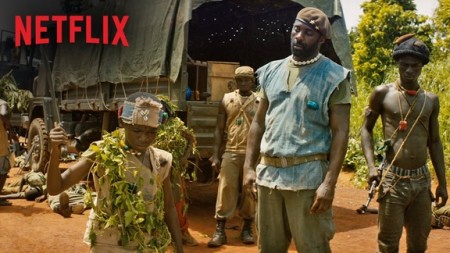A remarkable piece of filmmaking, redefining the Hollywood model.
Based on the 2005 novel of the same name by Uzodinma Iweala, “Beasts of No Nation” is an indelible story that is difficult to stomach but commands your attention. The narrative leaves you meditating upon the cultural significance it shares with many current global issues, and the contemporary examination of media distribution and race equality in Hollywood.
A benchmark for movie distribution, this is Netflix’s first original film released in October of 2015. The casual viewer may have heard this title mentioned on the fringe of Hollywood’s awards season this year. But, among the bevy of nominated actors and pictures vying for the gold, any consideration was non–existent.
Its absence instead fueled the controversy of #OscarsSoWhite.
The film shadows adolescent Agu (newcomer, Abraham Attah). His narration shapes the perspective of this haunting battle-filled opus. We quickly witness his playful innocence strikingly turn into a tragic life of war, murder, physical and sexual abuse. Agu and his family live in a West African “buffer-zone” village where civil war for political control and land ownership are occurring against a fallen government and military-aligned rebels. Agu’s family is murdered through one of many violent skirmishes. After narrowly escaping execution, he is discovered by a rising rebel group called the NDF. Their leader, Commandant (a visceral, Idris Elba) takes Agu under his wing, shaping him into a conflicted murderous soldier.
Written and directed by the artistically gifted Cary Fukananga (True Detective S1), the viewer forgets this is all choreographed imagery. The authentic documentary style affects every facet of your senses and conscience, leaving you to ponder how areas of the world can be so bleak. The vast heat of the African landscape, paired with the desperation of men fighting for what they believe is rightfully theirs, will provide you a conflicted headspace days after viewing. Its marathon runtime of two hours and sixteen minutes sometimes drags in between rising acts, but as a whole, the film works as effectively as a National Geographic front cover – showcasing a world few in The West are willing to acknowledge presently exits.
How can such an impactful film receive “0.0” Oscar nominations? You could point to its debated distribution model, its lack of marketing campaign, racial inequality, etc. It’s probably all of the above. This film wasn’t acknowledged because the system in which it exists is obsolete. If Hollywood allows a boutique film like this to receive accolades it not only re-writes the rules, it leaves them open for interpretation. Operating off of uncertainty is not a formula Hollywood invests in, especially when the goal is generally profits.
In a world where Netflix redefined what the meaning of television quality and consumption are, the industry as a whole is at a crossroads. New ways of producing and viewing content is changed almost daily. Albeit Netflix is still the king among many outlets, competing subscription services are now producing debatably the “golden-digital age” of television. This makes big studios nervous. How can they compete? For now, they fall back on blockbusters and a certainty of production cost return (i.e. proven narrative content and “name actors”). A numbered rise of “tent pole” films are being released year round, as well as a small number of studio indies. These small ones are modestly budgeted and released through iTunes or Netflix type outlets. The profit from online distribution and foreign markets keep the money train going. This is the current model. What would it mean to have a best picture come from Netflix? That’s the uncertainty. The academy – along with their outdated racial models – seems like it doesn’t quite understand how a “Netflix Best Picture” nomination could happen. The floodgates of what defines a best picture would be a conversation many didn’t have the foresight to discuss in 2016. Thus, the Academy is again toying with the idea of including ten best picture nominees in 2017.
The race issue…a sensitive topic with many opinions. There has always been race inequality in Hollywood. You can blame the production system, but the system is only as keen as what exists within it. African American films are often low-budgeted, under marketed and rarely noticed outside of the direct community for which they’re made. For every “Straight Outta Compton” there is a dozen you have never heard about. And the quality is almost never “Straight Outta Compton.” And not every feature film has the budget and producer savvy of Ice Cube and company. But, a discussion of quality vs. quantity is essential now. Quality products will gain quality returns, and these topics are not just specific to African American filmmakers, but to an entirely globalized economy where films are viewed internationally as well, and where diversity is de rigeur worldwide.
A willingness to change the method has to happen from the bottom, not the top. Casting is a different argument altogether. A pity it’s still a discussion. The best actor should get the best part. There is a reason Idris Elba is rightfully in consideration to play the next James Bond; he’s a brilliant actor. His exclusion from a traditional franchise like Bond, is an example of the systematic racism of the contemporary structure.
Revolution is always uncertain. Uncertainty in Hollywood doesn’t always yield monetary results. But the question Hollywood must ask itself is:
Is timeworn tradition more pertinent than progressive artistry?
–Steven Havira: Artist, Actor, Writer/Producer
